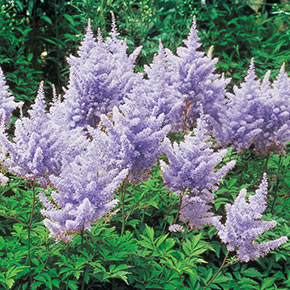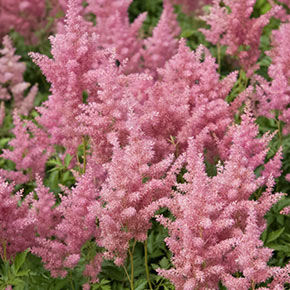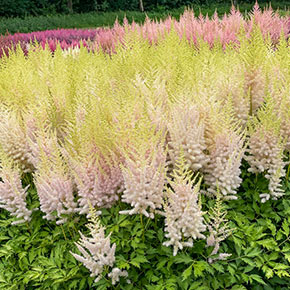-
Spring Planting
Order now for best selections.
-
Fall Planting
Available for preorder for fall 2025 delivery.
-
Bulk Flower Bulbs
Big savings on bulk orders!
- New
-
Gardening Resources
Flower Bulbs & Perennials at Wholesale Prices

How to Plant, Grow, and Care For Astilbe
| Botanical Name | Astilbe |
| Plant Type | Perennial |
| Sun Exposure | Partial shade to full shade |
| Soil Type | Well-drained, moist loamy, sandy or clay |
| Soil pH | Neutral to slightly acidic |
| Bloom Time | Spring or summer, depending on variety |
| Flower Color | Pink, purple, red and white hues |
| Hardiness Zones | 4-8 |
| Special Features | Both deer and rabbit resistant |
Astilbe, also called false spirea and false goat's beard, is an easy-care perennial that adds color, movement and texture to shade and woodland gardens. The feathery flower plumes provide beautiful color, and the fernlike foliage adds months of interest. They're an excellent companion to hostas, ferns and other shade-loving perennials. Both deer and rabbit resistant, astilbe is relatively trouble free.
Astilbe looks best and the flower plumes are most impressive when planted in groups of five or more. Learn more about when to plant astilbe roots, how to plant astilbe and other tips on growing astilbe here.
Types of Astilbe
Depending on the variety, astilbe may bloom in late spring to late summer. By selecting several different varieties, you can extend the bloom season for months. You can also choose a variety of flower colors and plant heights. Here are some popular astilbe varieties.
Astilbe Amethyst: Early flowering variety makes a big impact when its feathery lavender plumes open in early to midsummer. Grows 24 to 36 inches tall.

Astilbe Rheinland: Vibrant pink flowers add refreshing color to the summer shade garden. Blooming in early to midsummer, the plants grow 24-26 inches tall.

Astilbe Milk and Honey: Later blooming variety puts on quite the show. The fluffy, creamy white flower heads are tipped in a fresh green hue. As time passes, the flowers change to soft pink. Blooming in mid to late summer, the plants grow up to 30 inches tall.
When to Plant Astilbe
Astilbe can be planted in the spring or the fall. If planting in the fall, give the plants several weeks to establish their roots before the first frost date in your area. Gardeners can order astilbe bareroots and plants from mail-order catalogs or buy potted astilbe plants from nurseries.
Where to Plant Astilbe
Astilbe are hardy perennials and can be grown in zones 4-8. You can determine your grow zone using our zone finder. Astilbe are shade perennials and perform best in dappled sunlight or light shade. They grow best in moist, well-drained soil that's rich in organic matter. Astilbe plants don't like to be waterlogged, nor do they like dry soils. You can improve your soil by mixing compost or well-aged manure into it.

How to Plant Astilbe Roots
Most gardeners plant astilbe roots or plants, rather than start astilbe from seed. The seeds may rot in the ground before they germinate. When planting bareroot plants, dig a hole that is twice the size of the root mass. Place the plant in the hole and fill with soil. The crown should be 1-2 inches below the soil level. Press the soil down and water well. Space the plants 18-24 inches apart.
Materials You'll Need
For digging, you'll need a shovel or trowel. If planting in containers, make sure the containers provide adequate drainage. Without drainage, the plants will rot. Astilbe benefit from an all-natural, slow-release fertilizer, such as Van Bourgondien 100% Natural Perennial Food.
Growing Astilbe
Astilbe is a low-maintenance shade perennial. Here are a few tips for successfully growing astilbe.Astilbe Flower FAQs
What kinds of pests and diseases are associated with astilbe plants?Astilbe have few pests and disease problems. Japanese beetles may nibble on the plants, and powdery mildew could be a problem. Deer tend to leave astilbe alone.
How long do astilbe bulbs take to grow?
When planted as bareroots or potted plants, it may take astilbe a year before it blooms.
Why are my astilbe flowers rotting?
If astilbe are waterlogged or grown in overly wet conditions, they may rot. Likewise, if grown in dry conditions or too much sun and high temperatures, the leaves may brown.
What kinds of plants or flowers grow well with astilbe?
Astilbe grow well with other shade or woodland plants, including ferns, hosta, and other shade perennials.
| Shop Astilbe | |
| Shop All Shade Perennials | |
| See More Tips |
Have another question? Return to the Customer Service Help page or send an e-mail directly to Customer Service
Copyright © 2025 Gardens Alive!, Inc. d/b/a Dutchbulbs.com. All Rights Reserved. Dutchbulbs.com trademarks are registered trademarks of Gardens Alive!, Inc.
This site is protected by reCAPTCHA and Google Privacy Policy and Terms apply.
This site is protected by reCAPTCHA and Google Privacy Policy and Terms apply.

Item added to cart





